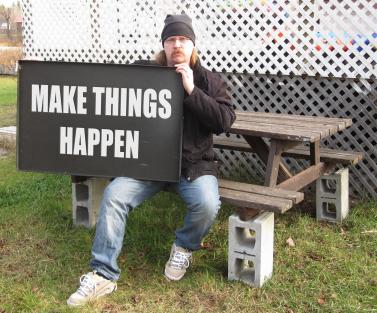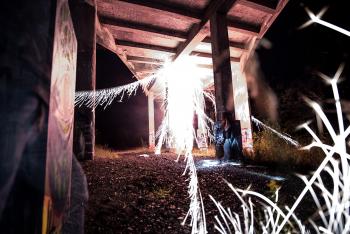Like this article? rabble is reader-supported journalism. Chip in to keep stories like these coming.
The Canada Council for the Arts is reinventing itself for the better according to new CEO Simon Brault.
The council is developing a new funding model, which will be put into action in April 2017, that is a radical departure from the way the council has been run for decades Brault says.
"The way we approach funding is now less the way it was imagined in the 1960s and more the way it should be imagined in 2016," Brault says.
The previous model was split into 10 different bodies and 147 different grant programs. It focussed on different disciplines such as dance, theatre and visual art.
The new program will consist of six core programs. It focusses on specific kinds of activities and projects.
Artists previously had to "evolve in narrower corridors of being," says Brault, but the Canadian artistic landscape is changing and this new model reflects the "blurring of frontiers between art forms and art practices." The new model will include an online forum where artists can make their own profiles and track the progress of their grant applications he says.
It will be more easily accessible for aspiring artists, will encourage diversity and will cater more specifically to Canadian indigenous artists.
Creating, knowing and sharing
One of the six core programs in the new model is called "Creating, Knowing and Sharing: The Arts and Cultures of First Nations, Inuit and Métis Peoples."
According to Aboriginal Arts Office Coordinator Steve Loft, this program has been years in the making. Loft, a Mohawk of the Six Nations, is a curator, artist and scholar with a long history of working with Indigenous art.
The Canada Council Loft said, was formed with the "national mythology of Canada," at its centre: the assumption that worthwhile artistic pursuits are European and white is part of this mythology.
During the Oka crisis of 1990 violence nearly erupted between a group of Mohawk people and and police officers in Oka Quebec, and it became clear to Loft that change was necessary.
Loft was at those first meetings in the early 1990s when the council began to counteract this mythology by planning specifically Indigenous programming.
Specifically Aboriginal programs were developed and Aboriginal program officers were hired.
This integrative approach was valuable Loft says. But it lacked cultural context.
Métis artist, curator and administrator Clayton Windatt says cultural gaps in understanding can become a barrier for Indigenous artists seeking funding.
"All groups that work within marginalized spheres have the additional constraint of having to constantly educate people as to why they're marginalized," he says.
Indigenous communities have a different definition of what an "artist" he adds.
"For example you say I'm going to do an event, I'm going to pay an elder an honorarium -- $250 to welcome everyone to the event and smudge the space," he explains "and they go well, is this a professional elder? You're paying artist dollars to them. How do we know that they're a professional?"
From Indigenous presence to Indigenous space
With the new program elders and traditional storytellers will be eligible for funding because they will be considered transmitters and carriers of culture.
"We contextualized all our policies and approaches and tools in order to support Aboriginal artists and artistic organizations in their own terms," Brault says.
Both Brault and Loft have long been on the Canadian arts scene but they're relative newcomers to the council. Brault became CEO 18 months ago and Loft became Aboriginal Arts Office Coordinator two years ago.
Loft is "a bit of a rockstar within the Aboriginal arts scene," says Windatt, so his involvement with the council caught the attention of artists across the country.
"We were all wondering how that's going to go because he's sort of outspokenly awesome on certain indigenous rights issues and really passionate... so how's that going to go? He's going to quit like two months later."
He didn't. He stayed and for two years the council consulted Indigenous communities and artists across Canada. They drew on the knowledge of Indigenous staff members who'd been at the council for more than 20 years, and had an evaluation done by an outside agency. Through these efforts a new program was created.
This new program acknowledges the three distinct indigenous groups within Canada: Metis, First Nations and Inuit. It will to be run by an Indigenous staff.
"There had to be an Indigenous space within council," Loft says. "We were still in a dynamic that placed indigenous art into colonial structures."
Under the Creating, Knowing and Sharing program the external people deciding who receives grants will be exclusively "indigenous artists, cultural carriers, and professionals," Loft says.
In the past, Indigenous arts organizations had to compete against well established, better funded organizations which were part of a dominant culture. Now says Windatt, they'll be weighed against other Indigenous artists, and judged by their peers.
Windatt also expressed excitement at the notion of microgrants. Microgrants will not be more than $3,000. The application process for them is simplified, making the funding more manageable and accessible for aspiring artists.
Windatt says he hopes the microgrants help active artists on reserves who don't know how or don't have the support to access funding. But he also hopes the microgrants will be made available to artists outside of the Indigenous arts program.
"I don't think the intimidation of applying as a first time applicant to the Canada Council or any Arts Council is unique to the indigenous population," he says.
Potential for change
The future of this program will be shaped by the amount of money made available to the Canada Council by the federal government. The budget will be announced March 22.

Brault says any increase in funds from the federal budget will be "invested in terms of the priorities set by the Canada council." One such priority will be the Creating Sharing and Knowing program he says.
While hopeful for the success of the new funding model Windatt isn't celebrating quite yet.
Because the equity office is being absorbed into the other programs he's concerned about other marginalized groups such as those who are disabled, who will be seeking funding.
"[The Council is] saying that representation and recognition and funding will be assured through these other programs but only by action will that actually be proven," he says.
Until the budget is announced no one will really know how much funding will be devoted to this new program Windatt adds.
He acknowledges the potential the model represents but until "there's dollar values I'm going to just stay with the potential." he says.
He's excited but "scared at the same time because there's a long history of having things presented to you and also finding out that they're not available later. That's being an indigenous person in Canada right now."
Loft says this is a critical moment for Canada -- this program part of a larger shift he says.
"The conciliation, the reconciliation, the acknowledgement and the full partnership of Indigenous peoples in the country is fundamentally the issue of our time. If we do not get this, if we do not move this, we don't move forward as a society," Loft says.
"My hope is that all of us... are part of that continuum and part of that movement to something that could be really profound."
Clarissa Fortin is rabble's current books intern.
Photos courtesy of Clayton Windatt




Comments
Do
Don't